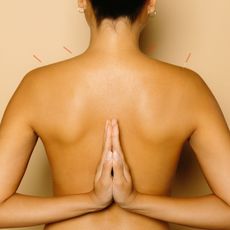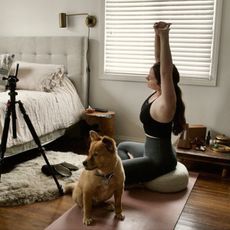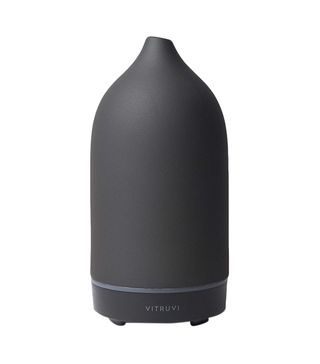3 Breathing Techniques to Try When Anxiety Is Taking Over

In this fast-paced world, anxiety can strike at any moment—even when nothing is causing you direct stress. It’s important to remember that you’re not alone in your struggle; there are many ways to move through these incredibly common yet complicated feelings. One of the most effective methods of dealing with anxiety is by focusing on your breathing through meditation.
“Meditation decreases your heart rate, promotes relaxation, and ultimately helps you understand yourself, your reactions, and your emotions better—helping you get through everyday life with greater ease,” says Tal Rabinowitz, founder and CEO of DEN Meditation.
Rabinowitz turned to meditation as a way to cope with the stress from her former job as executive vice president of NBC Entertainment. She eventually decided to open her own meditation studio in Los Angeles, where she’s now helping major celebrities like Amanda Seyfried, Drew Barrymore, and Rachel McAdams find peace and relief from stress.
Curious as to how she does it? Allow this meditation expert to explain the breathing techniques for anxiety that really work.

Basic Breathing
If the idea of sitting mindfully for more than one minute gives your anxiety more anxiety, don’t fret—breathing exercises are a simple and unintimidating way to begin practicing meditation. Rabinowitz explains that basic breathing practices release serotonin, dopamine, and oxytocin—all chemicals responsible for producing happy feelings. Because anxiety is connected so closely to breathing patterns, it’s not uncommon to experience shallow, deep, and hurried breaths in the midst of an anxiety or panic attack. “Healthy breathing can really shift how your body reacts and begin to calm you down,” explains Rabinowitz.
To do this exercise, start by closing your eyes and softening your entire body. Breathe in while counting for four seconds, breathe out for the same count, and continue this cycle. Remember that it’s okay if your mind wanders—simply acknowledge it and try to bring your awareness back to your breathing. “Like anything, it takes time and practice, and even when you become an experienced meditator, some days are just harder than others. Do not let it discourage you,” says Rabinowitz.
Alternate Nostril Breathing (Nadi Shodhana)
Rabinowitz says that the alternate nostril breathing technique (aka Nadi Shodana Pranayama) is great to practice before a particularly stressful situation, as it is meant to relax the whole body while calming your mind. Try it before an important job interview or high-pressure meeting to ease your anxiety. Here’s how to do it:
1. Sit up straight and make sure you are comfortable.
2. Put your right hand in front of your face, take your pointer and middle fingers, and place them between your eyebrows. The two fingers we will use in this exercise are the thumb and the ring finger.
3. Close your right nostril with your thumb, and exhale through the left nostril.
4. Inhale through the left nostril and, when complete, close it with the ring finger.
5. Release your thumb from the right nostril, and then exhale slowly and steadily.
6. Inhale through the right nostril and, when complete, close it with the thumb.
7. Release the ring finger from the left nostril, and exhale. These two full breaths are one cycle of the alternate nostril breathing exercise.
10. Repeat for five to 10 cycles.

Controlled Breathing
When you’re experiencing high amounts of anxiety or sitting on the edge of a panic attack, try practicing the controlled breathing technique. This technique will slow down your heart rate while relaxing your muscles and will trick your brain into thinking that it’s calm and rested. Here’s how to do it:
1. Sit somewhere comfortable. Close your eyes, and relax your jaw.
2. Inhale for two seconds.*
3. Hold your breath for one second.
4. Exhale for four seconds.
*Start off with these low numbers if you’re a beginner. You can work up to increasing your counts—just remember to exhale for longer than you inhale. For example, inhale for four seconds, hold your breath, and then exhale for eight seconds.

Body Scan
Rabinowitz says the body scan breathing technique “helps forge the body-mind connection.” If you’ve got a wandering, anxious mind, try this technique to help shift your focus. Here’s how to do it:
1. Sit or lie down in a comfortable position. Inhale and exhale to relax your body.
2. Start at the top of your head and bring your attention to your body. Stay still for a few seconds or minutes, focusing on your scalp. Breathe in and out to relax your head. When you feel your scalp relaxing, move on to another area until you reach down to your toes. Be sure to take your time with each individual body part. With each exhale, soften the focused area. Pay attention to facial muscles—eyebrows, eyes, cheekbones, nose, jaw, and ears—before you move on to your neck and shoulders, etc.
3. Assess how you’re feeling. Are you experiencing discomfort or tension? Are there areas that feel tighter than others? If so, breathe into it by imagining your breath flowing through that body part.
4. Acknowledge any feelings or thoughts and continue to breathe.
5. Continue to move down both sides of your body until the anxiety starts to dissipate.
This article was originally published on MyDomaine and has since been updated. Next up: how to reset your metabolism, according to a nutritionist.
Disclaimer
This article is provided for informational purposes only and is not intended to be used in the place of advice of your physician or other medical professionals. You should always consult with your doctor or healthcare provider first with any health-related questions.
-
 It's a Self-Care Summer: 5 Easy Tips for Staying Grounded and Centered
It's a Self-Care Summer: 5 Easy Tips for Staying Grounded and CenteredShow yourself some extra love.
By Raina Mendonça
-
 11 Things to Do If You're Dealing With Anxiety at Work
11 Things to Do If You're Dealing With Anxiety at WorkThese can help.
By Casey Clark
-
 If You're Super Stressed Out, These 17 Things Can Make You Feel Better
If You're Super Stressed Out, These 17 Things Can Make You Feel BetterTry them.
By Sarah Yang
-
 15 Things to Do If You're Feeling Super Stressed at Work
15 Things to Do If You're Feeling Super Stressed at WorkHow to avoid burnout.
By Sarah Yang
-
 After Just 4 Sessions, I'm Completely Hooked on This Ancient Wellness Treatment
After Just 4 Sessions, I'm Completely Hooked on This Ancient Wellness TreatmentIt's surprisingly relaxing.
By Drew Elovitz
-
 The Best Essential Oils to Stock Up on for Anxiety Relief
The Best Essential Oils to Stock Up on for Anxiety ReliefThese have powerful soothing properties.
By Sarah Yang
-
 11 Stress-Relieving Workouts to Try When You're Overwhelmed
11 Stress-Relieving Workouts to Try When You're OverwhelmedThese will help.
By Sarah Yang
-
 These Relaxing Yoga Poses May Actually Help You Fall Asleep Tonight
These Relaxing Yoga Poses May Actually Help You Fall Asleep TonightBreathe in, breathe out, and set your phone to airplane mode.
By Lindy Segal


